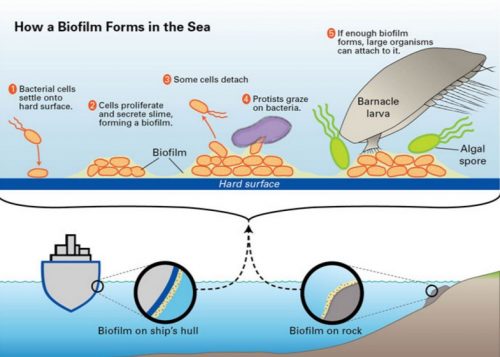The mechanical defense technique can be seen in marine creatures such as seals and crabs, which clean the surface of their bodies by brushing and mechanical treatment. Inspired by this technique of mechanical cleaning, an autonomous HullBUG (Hull Bioinspired Underwater Grooming) robot was developed, which proactively and gently cleans the bottom of the vessels while they are docked in the port, thus reducing the impact of the coupling on the vessel's performance.

to the previous article in the series
By: Yossi Cohen
Marine biofouling consists of colonies of organisms such as bacteria, microalgae, algae, fungi, crustaceans and invertebrates, which adhere to the hulls of vessels. The coupling causes a serious problem of increasing the drag of the vessel and slowing down its speed, and a great waste of energy. This phenomenon also causes the change of the ecosystem, due to the transportation of foreign organisms from one port to another in different geographical areas.
Many species of marine algae remain with a clean surface over time thanks to the use of chemical, physical, mechanical, or symbiotic protection techniques. In the previous newsletter we focused on physical techniques, in this newsletter, we will examine examples of chemical, mechanical, and symbiotic techniques:
As an imitation of the chemical protection technique, natural materials that repel coupling were extracted from marine algae, and innovative biocides were prepared from them, which were incorporated into the formulation of the paint. For example, it was found that the red alga Delisea pulchra repels biofilm development using the chemical Halogentaed Furanone, which is stored in glands on the surface of the alga, and is released from them in constant concentrations. Today Furanone is used as the active ingredient in antifouling paints produced in Australia.
The chemical Halogenated pyrrol, which inhibits the development of biofilm in sea sponges, is used as an active ingredient (trade name Econea) in Antifouling paints, produced by the paint companies: Petit, Interlux, Sea Hawk.
The mechanical defense technique can be seen in marine creatures such as seals and crabs, which clean the surface of their bodies by brushing and mechanical treatment. Inspired by this technique of mechanical cleaning, an autonomous HullBUG (Hull Bioinspired Underwater Grooming) robot was developed, which proactively and gently cleans the bottom of the vessels while they are docked in the port, thus reducing the impact of the coupling on the vessel's performance.
Most of the studied organisms combine several techniques for effective protection against the formation of fouling. The Echinoderm family, for example, which includes starfish, sea urchins, sea lilies, and more, combines brushing with the secretion of anti-infective mucus, and chemical treatment - and even uses an electrically charged cuticle to prevent biological settlement on their surface.
This approach, of combining different techniques to prevent fouling, is probably the ultimate solution - and this is the direction the scientists are currently working.
To the source of the news:
1. Biomimetic Strategies in Antifouling Coatings by Maria Salta - The Journal of Ocean Tech. Vol. 9, No. 4, 2014
2. Can Biomimicry and Bioinspiration Provide Solutions for Fouling Control? By Emily Ralston & Geoffrey Swain - Marine Technology Society Journal - July/August 2011, Vol.45, No.4.
